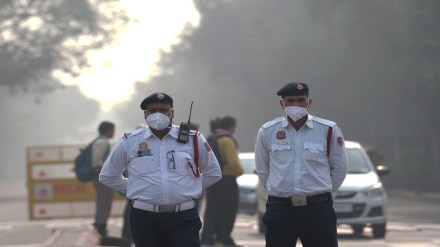The residents of Delhi continue to grapple with the poor air quality. The latest update reveals a notable shift from the ‘severe’ category to ‘very poor,’ with the Air Quality Index (AQI) standing at 324, as per the latest data released by SAFAR-India.
This shift not only prompts a closer look at the factors influencing Delhi’s air quality but also underscores the ongoing challenges faced by authorities and citizens alike in managing and mitigating air pollution.
The air quality recorded at Anand Vihar stood at 387 (very poor), at ITO Delhi it was 343 (very poor), RK Puram recorded an AQI of 415, and Wazirpur was at 422.
In the wee hours of Thursday, the air quality recorded at Anand Vihar stood at 387 (very poor), at ITO Delhi it was 343 (very poor), while RK Puram recorded an AQI of 415 and Wazirpur was at 422 both remained in ‘severe’ category. Consequently, at 7 am, the Okhla Phase-2 area was too recorded as ‘severe’, with an AQI of 406, as ANI reported.
Yesterday, at 7:00 am, Anand Vihar recorded an AQI of 405, Jahangirpuri registered an AQI of 428, and Major Dhyan Chand National Stadium and Dwarka Sector 8 had AQIs of 404 and 403, respectively, all falling into the ‘severe’ category, as per CPCB data.
On Tuesday, during a hearing in the Supreme Court regarding increasing air pollution in Delhi-NCR, the Court rebuked the Punjab and central governments, cautioning them against politicising the issue of stubble burning. The Court suggested measures to halt this practice, including considering the possibility of withholding monetary benefits like MSP on paddy from those involved in starting farm fires.
Also Read:Delhi gasps as air quality plummets to ‘severe’ category
On November 18 i.e. Saturday, a slight improvement in air quality prompted the CAQM (Commission for Air Quality Management) to lift the restrictions placed under the GRAP-4 action plan. This allowed buses to enter the city, except for BS-3 and BS-4 petrol and diesel vehicles. Additionally, restrictions on ongoing construction activities were also lifted.
What is the Air Quality Index (AQI)?
The Air Quality Index (AQI) is a vital tool for effectively communicating air quality status to the public in an easily understandable manner. It consists of six AQI categories: Good, Satisfactory, Moderately Polluted, Poor, Very Poor, and Severe.
Each category is determined based on the levels of ambient concentrations of air pollutants and their potential health impacts, known as health breakpoints. According to the AQI scale, air quality falls into the following ranges: 0 to 50 is ‘good,’ 51 to 100 is ‘satisfactory,’ 101 to 200 is ‘moderate,’ 201 to 300 is ‘poor,’ 301 to 400 is ‘very poor,’ and 401 to 450 is ‘severe’.
(With ANI Inputs)
